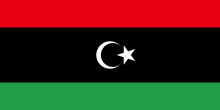Libyan nationalism
[1] Libyan nationalism began to arise with the creation of the Senussi religious orders in the 1830s that blended North African Sufism with orthodox Islam.
[3] During the 1840s the Senussi religious orders reached the borders of Libya with the help of Algerian sheikh El-Sayyid Mohammed bin Ali Al-Senussi,[4] also known as Grand Sanusi.
[8] In 1912, the European power invaded and annexed Tripolitania and Cyrenaica right after their recognition by the Turks through the Treaty of Lausanne.
After the Senussi orders had sided with the Ottoman Empire during the war and lost, Muhammad Idris took the lead in the negotiations with the British.
He finally rose to the throne when Libya was unified under a constitutional monarchy after the defeat of Italy and Germany.
[2] Inspired by Nasser in Egypt, Gaddafi joined his project of regional unity, also called pan-Arabism, aiming at creating a common Arab state.
[3] After this, there was a lack of leadership and unity filled by the National Transitional Council and Non-State (Armed) Actors.
[13] The non-state (armed) actors played an important role in the state-building of Libya after 2011: they have provided the Libyan people with, among other things, security and social services.
